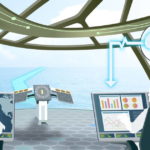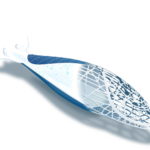A research project under the Japan Ship Technology Research Association (JSTRA) surveyed innovative technologies from various sectors and countries. This article is a shortened version of Kohei Matsuo’s presentation at this year’s HIPER conference, which was honored with the »HANSA Inspiring Visionary Award«
We investigated new technologies adopted in other industries and examples of advanced technology implementation in the maritime industry worldwide. Considering[ds_preview] the applicability of these technologies to the maritime industry was used as basis for discussing future ship technologies 30 years from now.
For our project, we surveyed literature and interviewed relevant parties (universities, research institutions, manufacturers, etc.) to extract technologies that could be applied to ships in the future. We also analyzed individual technologies from the viewpoint of feasibility/maturity and magnitude of impact. This led to a technology roadmap to organize short-term and medium-term R&D projects. We extracted noteworthy technologies (6 fields, total 116 cases) for future ship and analyzed them.
Advanced R&D seemingly focuses increasingly on a few specific areas: technology on the environment and energy, nanotechnology, information technology, and life sciences. The Japanese government has also focused its funding on those fields. The research results from the technology on environment and energy, nanotechnology and information technology can become directly applicable to the maritime industry. But even some life sciences (e.g. brain science) may lead to applications in future maritime technology.
Overall, the current fields of science and technology are likely to communicate and cross-fertilize in the future. The future lies not in developing single technologies in depth, but to combine and integrate technologies from other fields and other industries. Many interesting developments in maritime technologies can be found in the USA. While developed for the US Navy, many technologies can be applied just as well in the civilian sector.
Likely »game changing« technologies include innovation of shipbuilding, ship operation and logistics by information & communication technology (ICT). The following should be the material applied by nanotechnology.
Carbon may bring next revolution
R&D efforts have been made for higher strength and more flexible steels. These achievements are sequentially incorporated into the shipbuilding industry. Meanwhile, there is R&D on smarter materials or functional materials in other industries.
Future ship materials will increasingly involve composites of various materials (steel, carbon, and organic material). We see already the practical use of CFRP (composite fibre reinforced plastics) in the aerospace and automotive industries. The application of new nanocarbon materials such as carbon nanotubes (CNT) and graphene should be game changing for the maritime industry. Ship structures have moved from wood to steel. Carbon may bring the next revolution.
Nanocarbon material is not only a good structural material, but also a good functional material e.g. for built-in electronic circuitry, semiconductors or heat exchangers. Ship outfitting work may dramatically change (e.g. embedding electrical materials and printed circuit board directly into hull elements by printing). By realizing ultra-light ships, we may also see different hull forms and structural designs for volume carriers such as cruise ships, mega-yachts, ferries and navy vessels. Concept on LCA (life cycle assessment) including ship recycling would also be affected.
We may see increasingly high-performance materials with a variety of new features such as transparency, ability to reactively adjust shape or mechanical properties (biomimetic technology), self-healing, intelligence (with sensors embedded).
Simulation and Design
Along with increasingly available HPC (High Performance Computing), our capabilities in simulation have progressed, e.g. modeling directly complex turbulence or hydro-elastic fluid-structure interaction for ships. Simulation will proceed towards multi-scaled and/or multi-physics models, with high accuracy and high reliability. In the future, we can analyze and determine the behavior of ships or systems by only simulation (simulation-based design or one-shot manufacturing). Tailored on-demand production will be taken for granted in the future society.
In addition, simulation will spread to include non-technical aspects, such as the human element in a system (behavior model, human simulation, soft computing) or business models (Product-Service Systems, PSS). The focus will spread from the product itself to its service to maximize the product value. With respect to ship technology, various simulation technologies which are not only extensions of the classical applications (stability, hydrodynamics and structural behavior) are expected to evolve and support design and operation.
Data science or statistical science is likely to become more important and widely used. The importance of »data science« is recognized as the fourth science (fourth paradigm). For example, physics-based simulation will be enhanced and/or supplemented by data mining, Big Data analyses and employing artificial intelligence (AI) techniques such as machine learning.
In the design field, design errors are minimized by visualization and advanced verification, using a wide range of techniques including 3D CAD and Virtual Reality / Augmented Reality (VR/AR) technology.
Manufacturing and Construction
By introduction of the IoT (Internet of Things) in the production site, soon steel plates will be automatically conveyed by machines communicating with each other based on a predetermined construction plan from steel cut stage to the various assembly stages.
Further, it will be possible to record the complete building process through a spreading monitoring network of wearable devices all over the shipyard. These devices enable real-time traceability of the whole ship construction, allowing also quantification of a shipbuilding site’s ability or work skill.
Current standard procedures may change by the introduction of ICT technology. Currently, the design department and the production site have different roles and are separated in the shipyard organization. It is also believed to be more efficient to divide work processes as much as possible. With ICT technology, especially with the spread of wearable devices or AR technology, information is integrated between the design department and the production site. Digitization of shipbuilding sites will not only lead to mutual understanding between design departments and production sites, but may also lead to new ideas of »on-site design« or design incorporation to the production department which ultimately draw or determine the specifications in the manufacturing site and not in the design room.
At present, 3D printing can only produce small parts and has limitation in strength and type of materials used. However, these issues should be fundamentally resolved soon and 3D printing is expected to spread rapidly also in shipbuilding. This will in turn advance the use of composite materials in ships. The ONR (Office of Naval Research) of the US Navy published a report to explore the possibility of producing the whole ship using 3D printing. Already, it is possible to build houses based on 3D printing.
Automation and robotics are also important, increasing productivity and quality. In the aerospace industry, automation of production is progressing by expanding the use of robots in the production line of large passenger aircraft. The same trend is likely for shipbuilding.
ICT technology
Computers are embedded everywhere around us, but we are often not aware of them (transparency of computer). One of the R&D directions in ICT is on the fusion of humans, things (ship, yard) and computers. The fusion of the real world (Physical System) and cyberspace (Cyber System) will combine the wealth of information from penetrated sensor networks in the real world with the powerful computing capability of cyberspace.
Noteworthy in this movement is an effort to discover entirely new knowledge from the vast amount of information (Big Data). Management or policy initiatives are starting to get based on analysing correlations from Tera-bytes of data. We will be able to handle enormous amounts of data as never before, such as oceanographic data, marine data from ship operation, construction data from shipyards and personal data (e.g. health monitoring) from the crews and workers. This might lead to perspectives on ship design, construction and operation. We can make quantitative and rational decision, going beyond traditional intuition and experience.
Research looks into new ways of interacting with computers. New computer architectures mimic the human brain (neuro-synaptic computing). Future connection of the human brain and the computer may expand human capabilities; it may be possible to transmit one’s intention by downloading from the brain to a computer. Inversely, it may be possible to upload knowledge and skills. The craftsmanship of workers may be transmitted directly to the brain (such as neuro-feedback technique) rather than through instructing words or texts. Our notion of training through a tedious process of nurtured may become history. When this comes to happen, it will have a major impact to our society, especially to education and training schemes.
In any case, ICT technology plays a key role for innovations in various fields. Advanced ICT skill will be required by our maritime workforce and this has implications also on education.
Transport and Logistics
A variety of players in the retail and logistics industries are competing to build new infrastructure and business models. We see the emergence of large, highly automated logistics facilities with the ultimate goal to deliver products at customers’ specifications whenever and wherever they want it. It is inevitable that this trend will come to the field of shipping as well. Land-based and sea-based logistics will be tightly connected.
Various technology start to emerge to make shipping more competitive, such as the use of drones, unmanned operation of ships and ports, new ship concepts (such as cargo ships with changing hold arrangement changes for each voyage), or optimizing operations and logistics based on Big Data analysis. In addition to optimized transportation, we may also see new business models such as adding value to the cargo while transporting it.
IoT technology and Big Data analyses are already used for condition based maintenance schemes and performance monitoring of ships. In the future, we will see increasingly unmanned operation of ships.
Environment and Energy
Similar as for cars and planes, we will see shipping move towards low and eventually zero CO2 emission scenarios. The vision of a future zero emission ship (ZES) combines various energy-saving technologies and sources of renewable energy, such as wind and solar power, bio-fuels, tapping into wave and tidal energy. Hydrogen technology will play a key role, as hydrogen allows efficient storage of energy generated offshore, such as wave and wind energy, solar power or even artificial photosynthesis using offshore algae farming.
In general, sustainable shipping will play an increasing role. As we need to protect and preserve the habitat environment of our oceans, management of biological resources and water in a sustainable way will result in the demand for a “Non-negative Effect Ship” (NES). Design and operation of ships will then be aligned with this ultimate goal.
Survey on individual element technologies
• 116 promising future ship technologies were grouped in 6 technical fields:
• Materials
• Design and construction of ships
• Ship operation and maintenance
• Transportation and logistics
• Propulsion and engines
• New ship types (Other technologies)
For each element technology, time span of R&D and impact to maritime industry were estimated, leading to priority ratings for:
• CFRP material
• Self-healing material
Virtual ship laboratory
• 3D printing (additive manufacturing)
• Laser technology (cutting, welding, bending, etc.)
• Autonomous or unmanned ship
• Robotics (manufacturing robot, drone, nano robots, etc.)
• Asset Visibility
• Big Data analysis of logistics data
• Superconducting technology
• Hydrogen energy
Kohei Matsuo, National Maritime Research Institute, Tokyo/Japan, kohei@nmri.go.jp




















